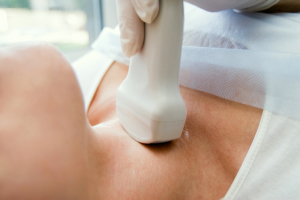Cancer testing, getting a tissue diagnosis and to staging the tumor
It is important to realize that tests for thyroid cancer are necessary when a patient develops a lump in the thyroid. To explain, the physician needs this information to make the diagnosis of thyroid cancer. Specifically, if there are relatives with thyroid cancer, a calcitonin blood level would be a very specific test to monitor for medullary thyroid cancer.
Notably, this type of thyroid cancer has a very good prognosis. The reason is that the physician diagnoses the thyroid cancer early and monitors the clinical condition after the surgical removal of the tumor. This helps to ensure that the cancer has all been removed and will not reoccur. Particularly, should the cancer come back, the physician would known right away what steps to undertake to combat it again.
Generally speaking, the principle in diagnosing thyroid cancer is to do cancer testing, get a tissue diagnosis and to stage the tumor. The following describes the methods that the doctor uses to monitor what is going on.
Diagnostic cancer tests
When there is a thyroid nodule (thyroid lump), the doctor would refer you to a specialist who will organize a biopsy of the lump. This procedure involves a mid-size needle the physicians uses up to 6 needle biopsies under freezing from all corners of this lump. This gives a good representation of tissue samples. The material is sent to the pathologist who will analyze these samples under the microscope and provide the treating physician with a tissue diagnosis. Before the biopsy is done the physician may decide to do other tests such as a thyroid ultrasound and/or a thyroid scan (=scintigram). With this scan a radioactive isotope (radioactive tracer substance) is given intravenously and after a period of time a scintigram is done at the Nuclear Medicine Department of a hospital. This will show the physician whether the tumor is “hot” or “cold”.
Cold scintigram tumors often cancerous
Mostly the hot tumor is harmless (histologically benign), taking up the tracer substance. If it is cold, and the ultrasound is showing a solid tumor, there is a high suspicion of a malignant tumor. However, all of these imaging studies are only images. There are false positives and false negatives with this thyroid uptake scan. A study was done to test this: thyroid nodules were classified using scintigrams into”hot” and “cold” depending whether they took up the radioactive marker( uptake=hot). All of the nodules were surgically removed and analyzed histologically. 5.5% of all nodules tested positive on scintigrams (=showed up “hot”). Of these there were still a total of 4%, which were cancerous (these had been labeled as false negatives). On the other hand, 85% of the nodules were “cold” and only 20% of these were malignant.
Cancer diagnosis is up to the pathologist
This shows that the tests have some usefulness in distinguishing between malignant and benign.The real proof, however, remains with the pathologist, as cancer is a tissue diagnosis. The physician requires a biopsy of the thyroid gland, which provides him with an accurate diagnosis. This in turn allows the physician to plan a proper therapy(Ref.1 and 2). However, when a patient gets the diagnosis of thyroid cancer, the staging of thyroid cancer is another important step before therapy begins. Click on “thyroid cancer” and look for this topic.
References
1. Cancer: Principles&Practice of Oncology. 5th edition, volume 1. Edited by Vincent T. DeVita, Jr. et al. Lippincott-Raven Publ., Philadelphia,PA, 1997. Thyroid tumors.
2. Cancer: Principles &Practice of Oncology, 4th edition, by V.T. De Vita,Jr.,et. al J.B. LippincottCo.,Philadelphia, 1993.Thyroid tumors.
3. CC Cheung et al. J Clin Endocrinol Metab 2001 May;86(5):2187-2190.
4. F Dede et al. Clin Nucl Med 2001 May;26(5):396-399.
5. S Hermann et al. Int J Cancer 2001 Jun 15;92(6):805-811.
6. I Sturm et al. J Clin Oncol 1999 May;17(5):1364-1374.
7. VL Greenberg et al. Thyroid 2001 Apr;11(4):315-325.
8. K Ohta et al. J Clin Endocrinol Metab 2001May;86(5):2170-2177.
9. Conn’s Current Therapy 2004, 56th ed., Copyright © 2004 Elsevier
10. Ferri: Ferri’s Clinical Advisor: Instant Diagnosis and Treatment, 2004 ed., Copyright © 2004 Mosby, Inc







